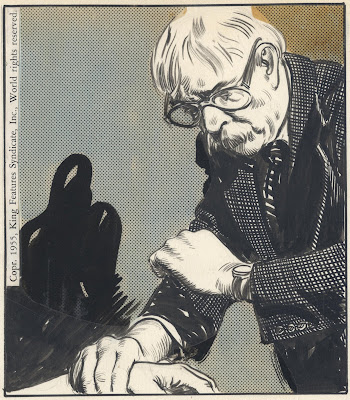THE TAIL ON THE DRAWING
I'm sure there's a technical name for those squiggly black lines that artists put in the background to complete a picture.
Unfortunately, I have no idea what they're called. More importantly, what rules govern their use? How does the artist know what shape to make them? How large or small should they be? What kind of lines work best in a particular situation?

Feliks Topolski
I often think artists use this device the same way many animals use a tail. A tail provides counterweight and balance for animals, enabling them to walk along tree branches or make sharp turns at high speeds. It keeps the animal stabilized and on target. Similarly, once an artist has completed the primary subject of a drawing, he or she sizes it up and often adds whatever abstract shape or weight is necessary to keep the picture in balance. When the artist finds that the demands of content and realism have tugged a picture away from a good design, those little black squiggles often restore what Oberhardt called "harmony."
Stan Drake
Unfortunately, I have no idea what they're called. More importantly, what rules govern their use? How does the artist know what shape to make them? How large or small should they be? What kind of lines work best in a particular situation?

Feliks Topolski
The great William Oberhardt (below) explained the rules about as well as they can be explained: "I follow only my feeling of harmony."
William Oberhardt
It's fun to watch the most tightly controlled, "realistic" artists use totally abstract splotches in order to round out a picture.
It's fun to watch the most tightly controlled, "realistic" artists use totally abstract splotches in order to round out a picture.
John Cullen Murphy
I often think artists use this device the same way many animals use a tail. A tail provides counterweight and balance for animals, enabling them to walk along tree branches or make sharp turns at high speeds. It keeps the animal stabilized and on target. Similarly, once an artist has completed the primary subject of a drawing, he or she sizes it up and often adds whatever abstract shape or weight is necessary to keep the picture in balance. When the artist finds that the demands of content and realism have tugged a picture away from a good design, those little black squiggles often restore what Oberhardt called "harmony."
Plus, a tail often serves another function: when a dog (or an artist) is happy or proud, a tail is something to wag.







